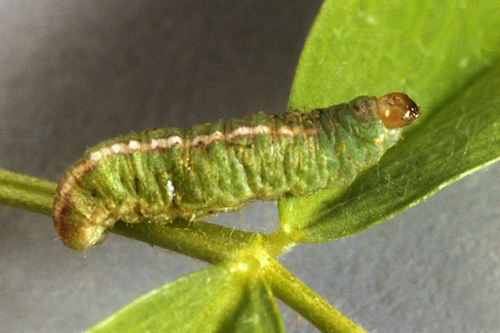Clover Leaf Weevil
Donus zoilus
The clover leaf weevil is a native of Europe, but has long been present in North America and is now established in most areas where clover and alfalfa are grown. It is also refered to as Hypera punctata, Hypera zoilus, and Brachypera zoilus in earlier literature.
|
Adult clover leaf weevil. (Tom Murray) |
 Clover leaf weevil larva. |
Life History
The adult is a brown weevil about 1/4 inch long with indistinct stripes on its back. Adults resemble alfalfa weevils, but are three or more times as large. They lay yellow oval eggs around their host plants, usually in the fall. A few weevils may overwinter and deposit eggs during mild days of winter or early spring. Most eggs hatch in the fall, but some remain through the winter. The young larvae from the fall-hatched eggs feed throughout the winter during mild periods and become full grown in late March to early May. Clover leaf weevil larvae look a lot like alfalfa weevil larvae in that both are green with a white line down the back. However, the clover leaf weevil larvae have a brown head capsule and feed on the lower parts of alfalfa plants, one, whereas alfalfa weevil larvae have a black head capsule and feed on the upper growing tips. Feeding occurs mostly at night, the larvae often hiding in leaf litter around the crown of alfalfa plants during the day. The later instars often have a pinkish color associated with the line down their back. When full grown they are just under a 1/2 inch in length, noticeably larger than larvae of the alfalfa weevil. Pupation takes place within an oval cocoon just beneath the surface of the soil or in debris near the base of the plants. Adults then emerge a few days later, usually feed for a few days, and then become inactive for most of the summer. Unlike the alfalfa weevil, there is only one generation per year.
Management
Clover leaf weevils are generally not an economic problem, unless they become numerous enough to impede plant growth in the spring. They are normally held under biological control by a combination of parasitism and disease. Scouting involves examing the crowns (case of plants) of 20 plants in five different parts of the field. Chemical control measures are only justified when there is an average 5 or more healthy larvae per crown.
Please refer to the most recent Alfalfa Insect Management Guide for specific control options.
Page last updated 4/16/2024 by J.P. Michaud.
